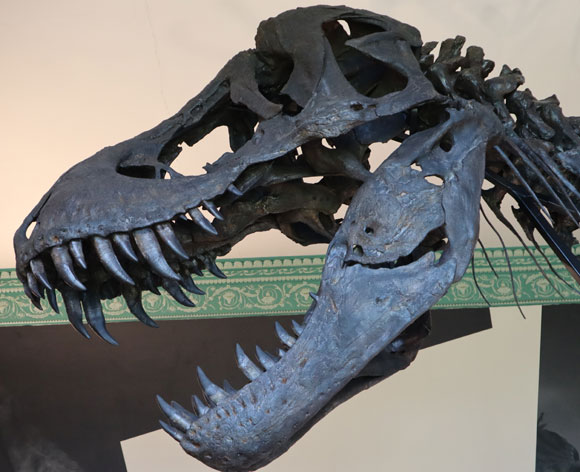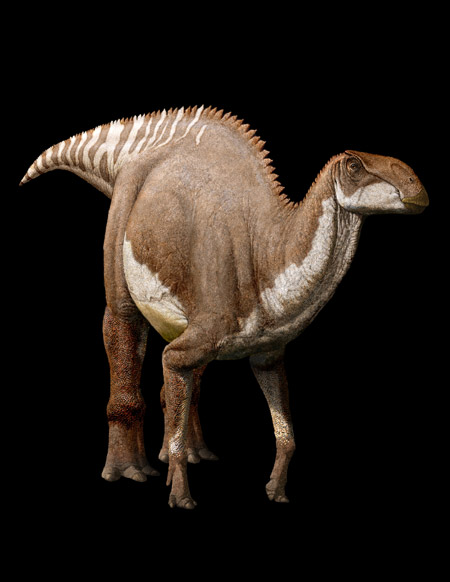T. rex Protein Shake
Doubt Cast Over Studies that Identified Dinosaur Proteins
One of the most controversial areas of palaeontology, perhaps within the whole of scientific endeavour, is the search for evidence of dinosaur organic remains within the fossil record. Could “Jurassic Park/Jurassic World” ever become a reality? In the future, could you see a Stegosaurus in a zoo or a Triceratops in a safari park? A re-analysis of an experiment carried out a decade ago, that claimed to have identified collagen in the femur of a Tyrannosaurus rex, has cast some serious doubts.
Researchers at the University of Manchester in collaboration with colleagues at the National Museums Scotland, have concluded that the protein sequences identified in the original study did not come from the Late Cretaceous, their source was somewhat more mundane and their discovery has more to do with cross contamination from bones of other animals analysed in the laboratory.
Tyrannosaurid Fossil Material – No Proteins Though
Picture credit: Everything Dinosaur
The Search for Dinosaur Proteins
The claim that protein sequences (peptides) had been identified in 68-million-year-old T. rex fossils caused a sensation. Remnants of organic material could have provided palaeontologists with tangible evidence, that one day, with ever increasing amounts of organic material being discovered, then it might just be possible to create animals reminiscent of these long extinct reptiles. Prehistoric proteins might well have supplied the first possible glimpse of the steps towards rebuilding dinosaurs. Think of it as “dinosaur cloning 101”.
To read an article that discusses the consequences of the original T. rex protein study: The Seemingly Impossible – the Hunt for Dino DNA.
The discovery, announced in 2005, was not met with universal acceptance and it caused much debate within the scientific community. A second study, this time on a duck-billed dinosaur Brachylophosaurus (Brachylophosaurus canadensis), undertaken by the same team identified permineralised blood vessels and further evidence of dinosaur proteins: Ancient Proteins from Duck-billed Dinosaur. This research was carried out in 2009 and replicated in 2017. Writing in the “Journal of Proteome Research” scientists from North Carolina State University with colleagues from North-western University and the University of Texas – Austin, repeated the 2009 study and replicated the results – claiming proteins from dinosaur collagen had been found.
Brachylophosaurus Illustrated
Picture credit: Houston Museum of Natural Science
Able to Repeat the Research and Reproduce the Results
One of the main criticisms of these experiments was that it was proving extremely difficult to repeat the work and get the same results. In addition, preventing contamination of the samples was a challenge, with many scientists casting doubts on the original research, claiming the proteins found were as a result of bacterial contamination.
Dr Mike Buckley (University of Manchester’s School of Earth and Environmental Sciences), an author of the newly published scientific paper in the “Proceedings of the Royal Society B” explained:
“The discovery of proteins in dinosaur bones sent a shockwave around the world, both among scientists and the public. It appeared that fiction was now being converted to fact through the application of new techniques.”
A team from Manchester University and the National Museums Scotland, led by Dr Buckley set out to explore the possibility of whether the claimed dinosaur peptides could have come from contamination from modern animals, given that ostriches and alligators were used as comparators and controls in the original research. The scientists analysed samples of bone from three different ostriches and found strong matches to all of the originally reported fossil peptides from both the T. rex and the Brachylophosaurus.
This new study emphasises the need for robust authentication criteria when attempting to identify biomolecular sequence information from truly ancient fossilised remains.
Museums Rather Than Zoos the Best Place to See a Tyrannosaurus rex

The skull of the T. rex exhibit on display at Wollaton Hall (Nottingham). Picture credit: Everything Dinosaur.
Picture credit: Everything Dinosaur
Dr Buckley stated:
“Our work set out to identify the collagen fingerprints for both ostrich and alligator and was not intending to debunk the previous studies. However, we soon realised that our results were pulling the rug from beneath the paradigm that collagen might survive the ravages of deep time.”
Can Organic Material Survive for Millions of Years?
The big question is whether or not delicate organic remains can survive for millions of years. There have been a number of papers published recently that have thrown up some surprising results, for example, back in 2015 Everything Dinosaur reported on the research undertaken at the Imperial College (London), that identified potential organic fibres (collagen) and cellular structures*.
There is a growing body of evidence to suggest that the one day, we might have a much better understanding of the biology of long extinct creatures. Microscopic remnants of collagen, a key protein within bone, has been found in several studies. However, the survival of collagen sequences beyond 3.5 million years old has not been achieved and validated by any other team trying to replicate work carried out.
Co-author of this research and Professor of Natural History at The University of Manchester, Phil Manning, added:
“The fossil record is offering new information on a daily basis through the application of new technology, but we must never forget that when results show us something that we really want to see, that we make sure of our interpretation. The alleged discovery of protein sequences in dinosaur bones has led many unsuccessful attempts to repeat these remarkable claims. It seems we were trying to reproduce something that was beyond the current detection limits of our science”.
Experiments Involving the Detection of Minute Quantities of Organic Material Require the Strictest Hygiene Measures
Picture credit: Dr Orlando
The researchers conclude that the controls used to constrain the evolutionary relationships between extinct and existing organisms have to be completely isolated from the subject of study (i.e. the dinosaur bone), so that the highly sensitive techniques do not pick-up residues of misleading contaminants. This is leading to a false ceiling for other scientists to achieve, which in reality is highly challenging. What was being described as dinosaur organic material, may just be the ghostly traces of the other organic material such as the protein sequences from the bird and reptile bones used in the research that are being picked up by the highly sensitive scientific instrumentation.
In conclusion, Dr Buckley stated:
“We are seeing something similar in our study, as to what happened with the ancient DNA world over twenty years ago when the scientific world had to recalibrate their aspirations when it came to the survival of this delicate molecule of life through deep time. It seems that the idiom that exceptional claims require exceptional evidence remains.”
Regardless of the true nature of the dinosaur peptides, this new study highlights the difficulty of differentiating such sequences with confidence. The results not only imply that cross-contamination cannot be ruled out, but that appropriate measures to test for the accuracy of the results stated should be further evaluated.
*To read more about the research undertaken by the Imperial College London: Fibres and Cellular Structures Observed in Dinosaur Fossils.
Everything Dinosaur acknowledges the help and support of the University of Manchester in the compilation of this article.
Visit the Everything Dinosaur website: Everything Dinosaur.




